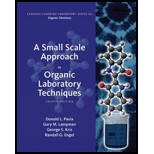
Interpretation:
The reason for the low mobility of chlorophylls on column chromatography is to be determined.
Concept introduction:
Column chromatography is a technique in
Answer to Problem 1Q
Chlorophylls are polar compounds. Therefore, chlorophylls tend to attach with the silica in the column which are also polar. Carotene are less polar compounds which easily elute through the column.
Explanation of Solution
In column chromatography, a long column is used that is packed with a polar compound such as silica or alumina. This compound acts as the stationary phase of the process.Silica (or alumina) is a polar compound. Usually, polar compound interact with other polar compounds due to attractions between them. When sample is passed which contains both silica and alumina through this column, chlorophyll tends to retain in the column while carotene elutes first. This is mainly because chlorophyll is a polar compound that retains in the column. Carotene is a less polar compound that elutes from the column.
The
Chlorophyll is a polar compound while carotene is a less polar compound. In the presence of a polar stationary phase, chlorophyll moves slower than carotene because chlorophyll attracts to the polar stationary phase.
Want to see more full solutions like this?
Chapter 15 Solutions
A Small Scale Approach to Organic Laboratory Techniques
- Use a suitable model to explain how separation and identification of a mixture of organic compounds can be achieved with a thin layer chromatographic (TLC) technique.arrow_forwardWhat is the effect of mobile phase on each (known) sample when doing Gas Chromatography?arrow_forwardIn kool aid chromatography, why does reducing the dilution of 2-propanol result in its decrease in polarity?arrow_forward
- While preparing the mobile phase to run a monoamine neurochemical HPLC analysis, you miscalculated the amount of acetonitrile you needed to add to your aqueous solution and came up with a 20% acetonitrile solution. How would this small mistake affect the resulting chromatographs?arrow_forwardThin Layer Chromatography why the non-polar compounds move up the plate most rapidly (higher Rf value), whereas polar substances travel up the TLC plate slowly or not at all (lower Rf value)? Please help me explain this question! Thank you so much!arrow_forwardThe identity and ratio of solvents are necessary in chromatography for achieving a good separation. What would happen if your solvent had an overly polar TLC developer? What would happen if it was overly non-polar?arrow_forward
 EBK A SMALL SCALE APPROACH TO ORGANIC LChemistryISBN:9781305446021Author:LampmanPublisher:CENGAGE LEARNING - CONSIGNMENT
EBK A SMALL SCALE APPROACH TO ORGANIC LChemistryISBN:9781305446021Author:LampmanPublisher:CENGAGE LEARNING - CONSIGNMENT Principles of Instrumental AnalysisChemistryISBN:9781305577213Author:Douglas A. Skoog, F. James Holler, Stanley R. CrouchPublisher:Cengage Learning
Principles of Instrumental AnalysisChemistryISBN:9781305577213Author:Douglas A. Skoog, F. James Holler, Stanley R. CrouchPublisher:Cengage Learning


